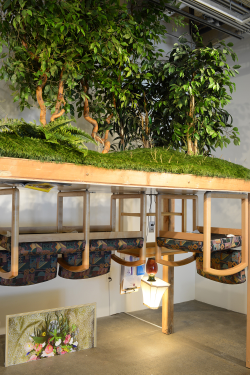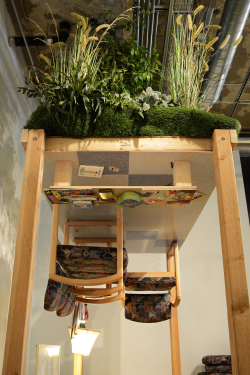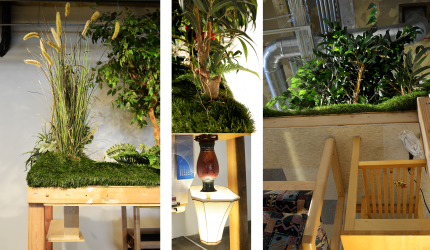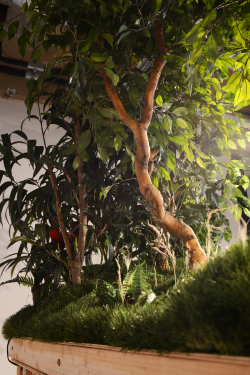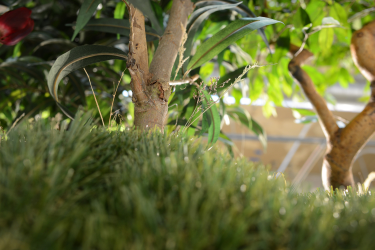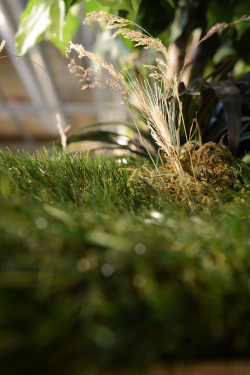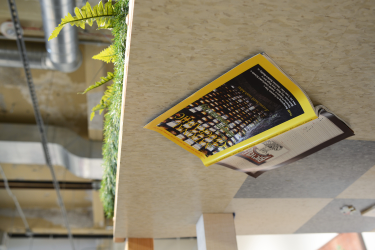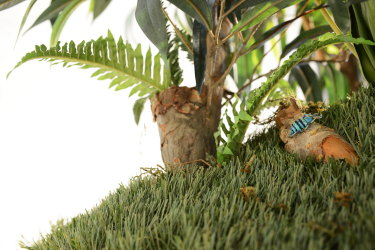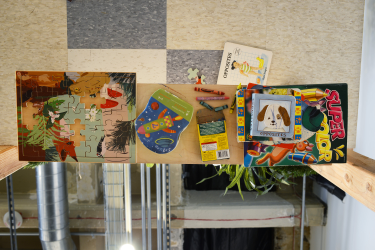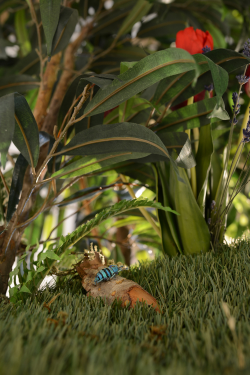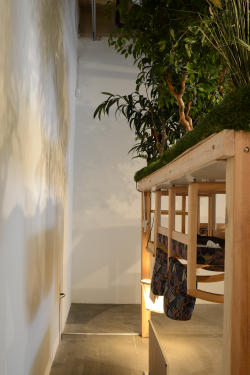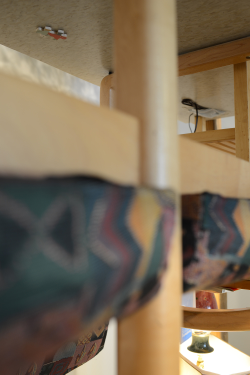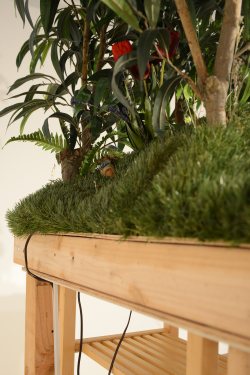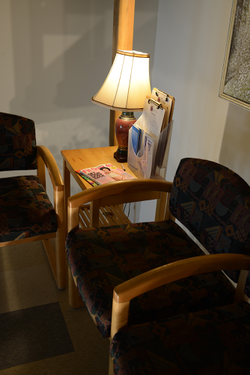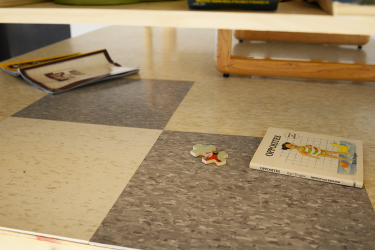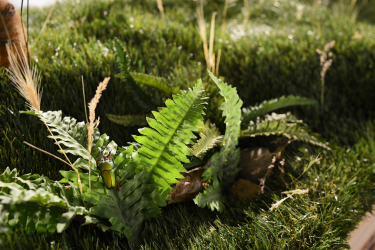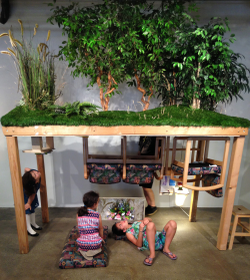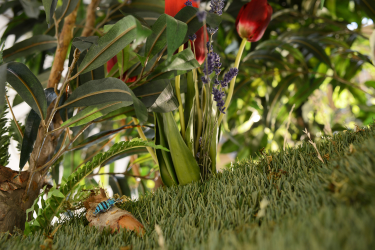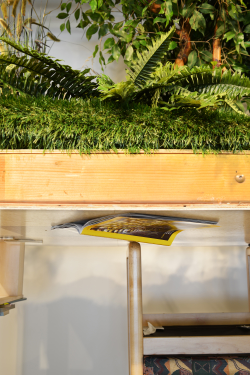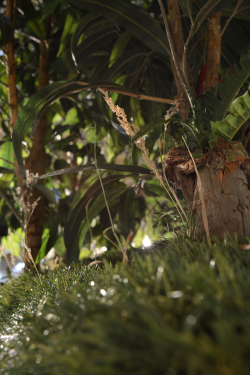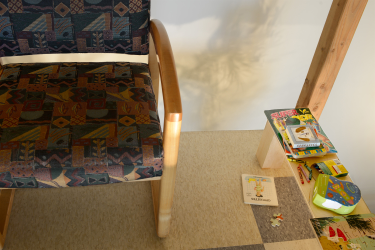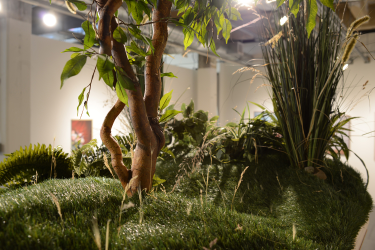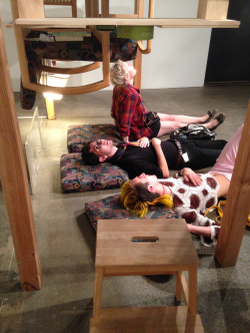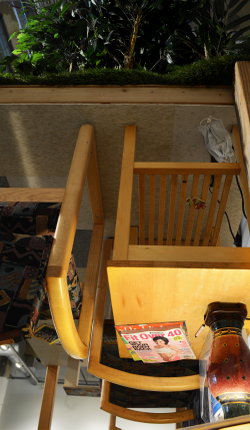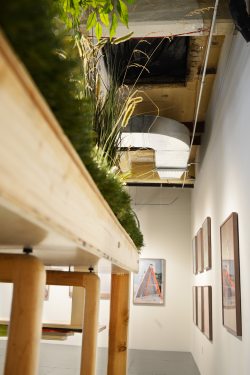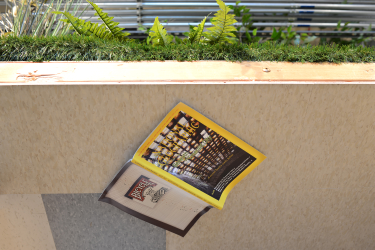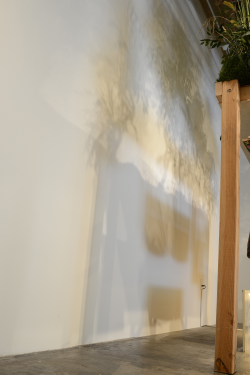
Waiting Room (Translated)
20178' W x 10' H x 4' DWaiting room furniture, plants
Waiting Room (Translated) is an installation I built in 2017. It’s 8 feet wide, 10 feet high, and 4 feet deep. It features a meticulously rendered upside-down medical waiting room, with a landscape above.
As the title suggests, every object in the waiting room below is directly translated above into an object from nature.
The installation was designed to be experienced from all sides and perspectives. Regardless of your vantage point, it is a mix of believable and disorienting. In fact, it's because of the believability of each built environment that it becomes so disorienting. Filled with specificity and doggedly ordinary objects, there are enough details to allow the viewer to let themselves get lost in the environment, until their eyes convince them that what they are seeing is normal, and it is they who are out of place, upside down, floating above.
A footstool is provided to allow viewers to visually explore the thicket, and floor cushions provide a comfortable way to lie down and take in the waiting room. When relaxing directly below and looking up, there is a feeling of delight and then discomfort, where the playful novelty of a room built upside-down shifts into the suspicion that the viewer is somehow suspended above a perfectly ordinary waiting room.
The careful banality of this scene is what makes the illusion work so perfectly. The inclusion of a functional lamp allows even the shadows in the room to contribute to a realistic atmosphere. A framed photograph, chopped in half, suggests both a back wall and an extension of the room right into the gallery floor. Traditional waiting room objects, casually placed, create a feeling of populated use, as though someone had just set down a magazine, or opened a box of crayons, or read a book, just a moment before.
In order to both establish a completely believable scene and to hint at my own narrative I created fake medical paperwork and brochures (Oversharing and ADHD). The clipboards have paperwork ready to fill out, but the form is actually an autobiographical account of my own family history, with custom questions which reveal why I have been in medical waiting rooms. By using believably dated graphics and an authentic brochure voice, I can provide a passive way for viewers to discover the emotional and brutally honest reasons for making this installation, but without breaking the feeling that they are inhabiting this room. Some of these materials are very sad, but there is humor mixed in, because of course we are so glad that medical waiting rooms exist, even though we never, ever want to be in one again. Other materials are less sad, but no less honest or autobiographical.
To encourage people to really involve themselves in the piece, to explore it until it feels immersive, and to further hint at my reasons for making it, there is a puzzle in the children's area, with three missing pieces. I hid the pieces throughout the waiting room, putting them in places where puzzle pieces might get lost. And then in the scene above I placed specific objects in exactly the corresponding spot, so there is a concrete reason to enjoy the peaceful artifice of this natural diorama.
The park is made of real and artificial plants. Some of the artificial plants I bought on craigslist, and others I made from real tree branches, using a small dremel bit to drill holes and carefully embed sticks and leaves. I harvested bark from plants in my yard, gluing them together with hand-painted polyester fronds to create small moments. To impose some randomness and natural mess, I made fabric dandelions, and positioned individual pieces of straw and weeds within the artificial grass.
Creating a beautiful, moment-specific diorama makes the hunt for the puzzle pieces’ pairs enjoyable, and the hunt itself gives the viewer a reason to spend time in this peaceful landscape.
You cannot get completely lost in it, however, because it's not hiding the fact that it’s an artificial landscape. While intentionally picturesque moments hold our attention long enough to be engaging, we never forget that these things are not real, that the more realistic location, despite its inversion, is the waiting room below, and these things are just meretricious placeholders for abandoned surgical masks, broken crayons, Highlights Magazine.
Because that's what this installation is about - I’ve been in far too many medical waiting rooms, for far too many reasons, and the way I stay sane when I'm there is by doing exactly this - imagining myself outside, in nature. I look around and deliberately ask myself: what would this brochure stand be, if it was a plant? Could this floor be lawn? The chair I'm in is a tree, and the crayon on the floor is a root poking up through the grass.
I imagine myself somewhere exactly the same but different, doing what we can all do whenever we have to - honestly, we are all more than an accumulation of moments; each of us is bigger than we are - even when we’re stuck in circumstance we are simultaneously greater than the sum of our parts.
Staring up at this waiting room, there’s a moment for every viewer when it flips - when their eyes insist that what they're looking at is normal, and they are the ones out of place - which contributes to a fleeting feeling that you're floating above the patient chairs and scuffed floor - that you're in a place which is real, but you’re not settled in it, you’re just outside of it, apart.
In the same way that while above we’re always aware of what's below, when lying beneath the waiting room there are hints to what’s above. Sometimes it’s the shadows of leaves and trees on the gallery wall; or a fern, breaking the visual continuity of such a perfectly boring floor.
Another detail that let me insert my own narrative in the scene is the mock National Geographic (no American medical waiting room is complete without it). The cover is a photograph of Seattle’s old downtown, now underground; the articles listed are crucial issues which are regularly buried, but to our own detriment.
Whether you approach this installation as an exercise in mapping and matching, or as a fascinating willful physical disorientation, or if you choose, whether you go a bit deeper into the personal and emotional reasons behind its creation, my goal here is to nudge us out of our ordinary selves, and to carry this idea beyond the gallery, so you might step onto the sidewalk and continue the thought process - that crack in the pavement, that could be a river; the parked car, a fallen tree; the garbage can a bush, the coffee cup a nest, and so on.

